Emu: Australia’s Giant Bird
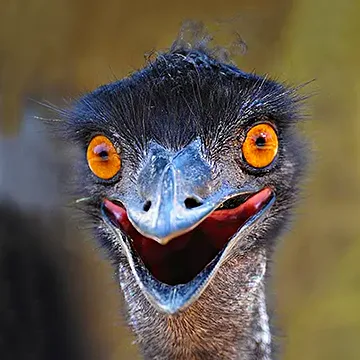
Contents
What is an Emu?
The emu is a large flightless bird with shaggy feathers, long neck and legs, and intimidating red or orange eyes. Standing up to 2 meters tall and weighing up to 60 kg, the emu is the second tallest bird in the world after the ostrich and the fastest runner in Australia. It has only tiny vestigial wings and its feathers are bifurcated, that is: two feathers growing from the same shaft, giving them a soft, shaggy look that isn't very waterproof. Despite its size, the emu is generally peaceful but can inflict serious injury if provoked. It is an excellent swimmer and spends its days foraging, preening, resting. Emus can live 10-20 years in the wild and up to 35 years in captivity.
Emu Other Characteristics
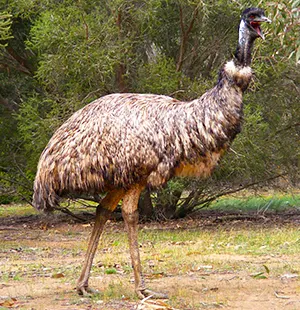
Photo: Emu with its tiny wings (in front of its leg)
Emus have soft, slender beaks about 6 cm long, perfectly designed for snatching up insects and tiny seeds. Each emu also sports a distinctive hairstyle, giving it a one-of-a-kind look.
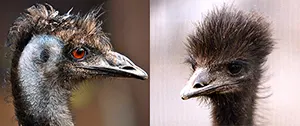
Photo: Each emu has a distinctive hair cut
The emu, being a flightless bird known as a ratite, lacks an extension to its sternum (breastbone) called a keel on which flight muscles are usually anchored. Interestingly, although it is flightless and lacks a keel, it still has tiny 20cm long vestigial wings. The emu manipulates these tiny wings while running to control its balance and direction. For example, when changing direction rapidly, the emu points one wing up and the other down, almost like a child "playing airplane".
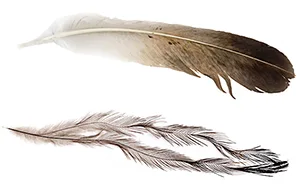
Photo: Two feathers growing from the same shaft
The emu's feather structure is bifurcated, with two feathers growing from the same shaft with no interconnecting barbs (bottom photo). This is distinct from most other birds that have a feather with a single shaft with smooth bristles and interconnected barbs (top photo). The Emu rattles its tail feathers to scare off unwelcome visitors.
Emu Sounds
Emus make deep-throated drumming sounds using a thin-walled 30cm (12in) long tracheal pouch in their windpipe. They also make other sounds depending on their gender. Adult males usually make a pig-like grunting sound, while adult females make a loud booming sound. Young birds make whistling sounds. Both sexes sometimes boom or grunt during threat displays or upon encountering strange objects. An Emu may also rattles its tail feathers to scare off unwelcome visitors.
Emu Running
The emu has two long, thin legs, each ending in three large toes with prominent toenails. The undersides of the toes contain flat pads that enable the birds to grip surfaces firmly while running or jumping. An emu can jump to a height of almost two meters, run up to 50kmh (30mph), and travel long distances at this speed without tiring.
Emu Habitat Where Do Emus Live?
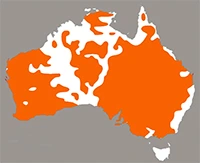
Emu Habitat Map
Emus live throughout Australia in a habitats that include grassy plains, forests, and areas with eucalypt, wattle and banksia plants. Its habitat range extends from the high snow country to the arid interior of the continent. Emus have also adapted to the presence of humans and are often found around man-made watering ponds. Emus are highly nomadic but generally remain in a fixed location if adequate food is available. However, when food is scarce, these flightless birds may migrate hundreds of kilometres in search of water and food at an average speed of 15–25 km per day.
Emu Diet What do Emus Eat?
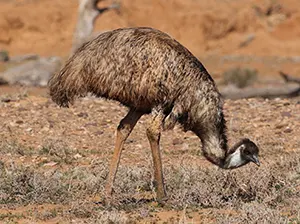
Photo: Emu eating
Emus forage during the day and have a varied diet consisting primarily of fruits, seeds, grasses and shoots of plants like Acacia or Casuarina. They also supplement this diet with animal-based food such as insects, spiders, snails, millipedes, and small animals. Emus do not chew or tear up their food. Instead, they swallow their food whole and consume occasional pebbles to help break it down in their gizzard. When food is plentiful, emus store large amounts of fat in their bodies. They use this fat reserve to survive in hard times, and while the male emu is incubating eggs, during which time it does not eat or drink but lives on its fat reserve instead. Despite drinking infrequently, emus can consume up to 18 litres of water when available. This high water requirement in very hot weather is necessary because they use cutaneous evaporation and panting to prevent overheating.
Emu Reproduction & Life Cycle Baby Emu
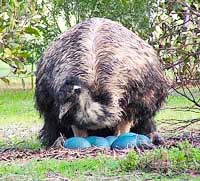
Photo: Male Emu incubating eggs
Emus usually pair up in summer and breed in winter. During mating season, the female's neck turns blue, indicating her readiness for courtship. First, the male builds a rather basic nest consisting of a slight hollow in the ground lined with trampled bark, grass, sticks and leaves. The female then lays 8 to 10 large shiny green eggs that look like avocados and weigh nearly 680 grams each. (That's the equivalent of about 12 chicken eggs).
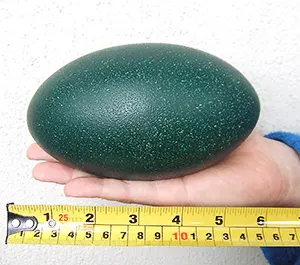
Photo: An emu eggs is huge
Once the female has laid her eggs, she abandons them and walks away, leaving the male to look after the brood. The male sits on the eggs for about 60 days and incubates them. During this time he rarely eats, drinks or leaves his nest. While he is incubating, his metabolism rate drops, and he may lose as much as 8 kgs in weight.
A newly hatched Emu weighs about 500 grams and is small enough to fit in your cupped hand. But emu chicks have an impressive growth rate, increasing their body weight nearly 80 times in the first 18 months of life. An emu chick's body is covered with downy black and white striped feathers arranged in a squiggly pattern. This colouration helps break up the outline of the chick's body, camouflaging it from predators.
The male parent emu cares for his chicks for up to 18 months, and most survive to adulthood. Emu chicks follow their father everywhere, whistling softly to each other and eating tender plant shoots. The whistling becomes louder and high-pitched if they feel threatened or lose sight of their father. The chicks reach breeding age at two years of age.
Emu Predators and Threats What Kills Emus?
The adult emu did not have native predators until the introduction of animals by humans. Since then, it has dealt with ground-level predators such as dingoes, dogs, and feral cats by running away at top speed. While doing so, it raises one wing and lowers the other, quickly swivels 180 degrees like a child "playing airplane", and speeds off in a different direction. Its four-legged pursuers cannot turn so rapidly and overshoot the emu as it heads off in another direction. As a result, the emu can usually exhaust its predator before the predator can catch up with it.
Emu Conservation Status Is the Emu Endangered?
There were once three types of emus in Australia. But the Tasmanian emu and King Island emu became extinct shortly after European settlers' arrived in 1788.
With an estimated population of between 650,000 to 750,000 wild emus, their population is considered stable and not threatened. Furthermore, human agriculture in the Australian Outback may have contributed to an increase in the emu population because humans watering holes for sheep and cattle are also used by emus. There are also many emu farms where the birds are raised for their meat, leather and oil.
Wild emus today are protected by law. Harming them is illegal.
How the Emu Got its Name What is a Male, Female and Baby Emu Called?
The most likely entomology for the word "emu" is that it was an Arabic word that early Portuguese explorers adapted as "ema" to describe large birds such as the ostrich. They subsequently used the term to describe cassowaries they discovered in Indonesia and New Guinea. It was then used by other European explorers, such as the Dutch, to describe the bird we know today as the Emu.
A male emu is called a cock
A female emu is called a hen
A baby emu is called a chick
25 Emu Facts
- The emu is the largest and fastest land-bird in Australia.
- And the second tallest and the second fastest bird in the world.
- The Emu lives mainly in open plains and woodlands throughout Australia, except Tasmania.
- It can run at 50kph for long distances.
- An emu can also jump 2m straight up.
- Each emu has its own unique hairstyle.
- The emu cannot walk backwards because of how its knee joints are constructed.
- It has only stubs for wings and cannot fly.
- It uses its stubby wings like rudders when running fast.
- The emu is the only bird with calf muscles.
- The Emu rattles its tail feathers to scare off predators.
- It makes a deep-throated hollow, drumming sound and grunts and hisses.
- It has two sets of eyelids, one for blinking and the other to keep out dust and dirt.
- The female emu's neck turns blue during the mating season.
- The emu's feathers are bifurcated- two feathers grow from the same shaft.
- As a result, its feathers are soft, shaggy and not waterproof like other birds.
- They are good swimmers and love to frolic in ponds and lakes.
- They shake water off their bodies like a dog does.
- Emus are omnivores but they are mostly vegetarian.
- Emus swallow their food whole.
- Emus drink water infrequently.
- An emu egg is 12 times larger than a chicken egg.
- The male incubates the eggs for about 60 days.
- He rarely leaves his nest and may lose up to 16% of its body weight during this time.
- Emus became extinct on the island of Tasmania because humans killed them off.
Learn More About Australia's Incredibly Quirky Animals
All Rights Reserved. (Last Updated: May 25, 2025)
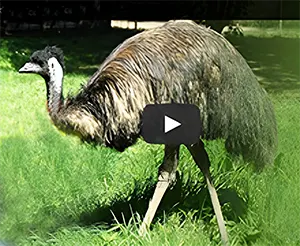
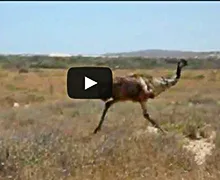 Watch Video of Emu Running
Watch Video of Emu Running